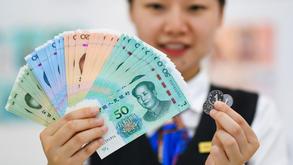 A woman shows banknotes and coins included in the 2019 edition of the fifth series of the renminbi. (PHOTO / XINHUA)
A woman shows banknotes and coins included in the 2019 edition of the fifth series of the renminbi. (PHOTO / XINHUA)
To ensure adequate liquidity in the Chinese banking system, the People's Bank of China, the central bank, announced on Monday it has lowered the cost of borrowing for its medium-term lending facility, a key policy rate known as MLF, for the first time since April 2020.
The interest rate on 700 billion yuan ($110 billion) worth of one-year MLF loans has been lowered by 10 basis points to 2.85 percent, the PBOC said.
This could help companies lower their financing costs and boost the real economy, the part of a country's economy that produces goods and services, analysts said.
On Monday, the PBOC also cut the interest rate on the seven-day reverse repurchase agreements by 10 basis points to 2.1 percent, injecting 100 billion yuan into the market.
The A-share market cheered the PBOC's twin rate cuts. The benchmark Shanghai Composite Index closed 0.58 percent higher at 3541.67 points and the Shenzhen Component Index rose 1.51 percent to close at 14363.57 points.
The policy interest rate cut follows the Dec 15 cut in the reserve requirement ratio by 50 basis points.
Lu Ting, chief China economist at Nomura Securities, said another 10 basis point cut of the MLF rate can be expected before June-end.
Jiang Qijia, senior analyst at Noah Holdings Ltd, a financial market services provider, said Monday's MLF rate cut is largely in line with the market expectations of a policy rate cut in the first quarter of the year, but only carried out at a faster pace.
The lackluster macroeconomic readings in December may have prompted the PBOC move, said Jiang. Retail sales of consumer goods contracted by 1.7 percent month-on-month in December. Property investment also plummeted 14 percent in December from a month earlier.
Given the relatively higher Producer Price Index data, a policy rate cut in the first quarter is crucial to further lower companies' financing costs, said Li Chao, chief economist at Zheshang Securities.
Guan Qingyou, chief economist at the Rushi Financial Institute, said the first half of this year is the time window that China should seize to further relax the monetary environment before the US Federal Reserve hikes its key interest rates.
Following the MLF rate cut on Monday, the one-year loan prime rate, the benchmark lending rate, may be lowered by 5 to 10 basis points this month, said analysts from the Bank of Communications Research Center.
The financing costs of the real economy will thus be further lowered together with other structural monetary policy tools, the analysts said.
Wang Tao, chief China economist at UBS, said in an interview on Jan 11 that China's central bank may lower the RRR again this year, perhaps in March or May. There may be other tools to further increase liquidity in the market but the policy interest rate will not be lowered this year, she said.


